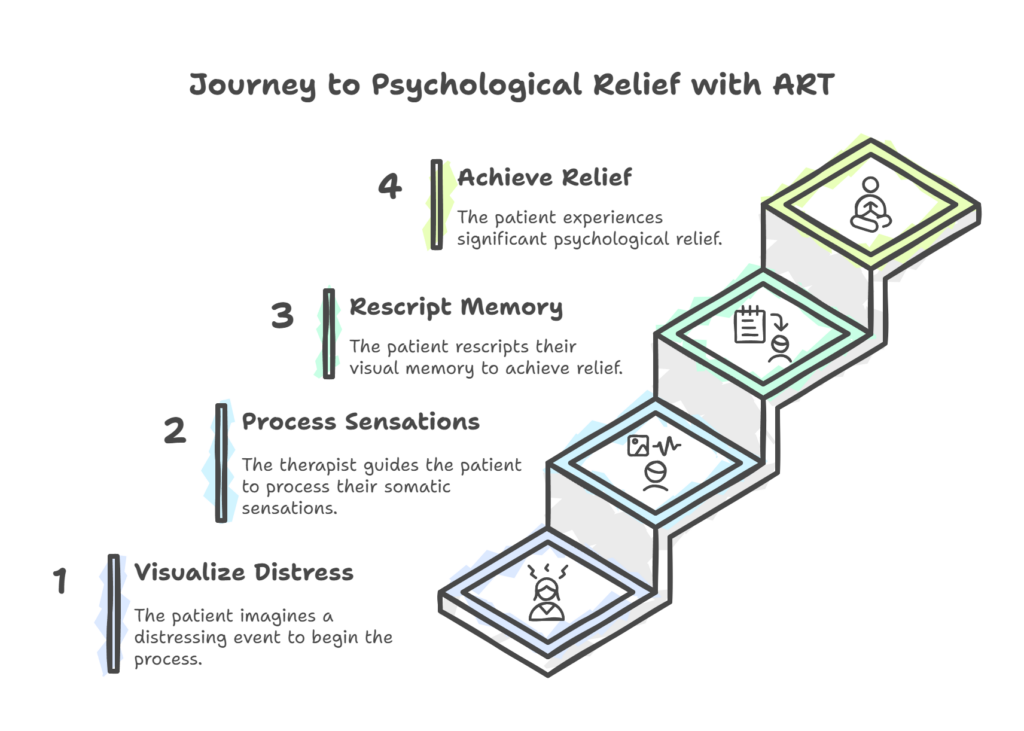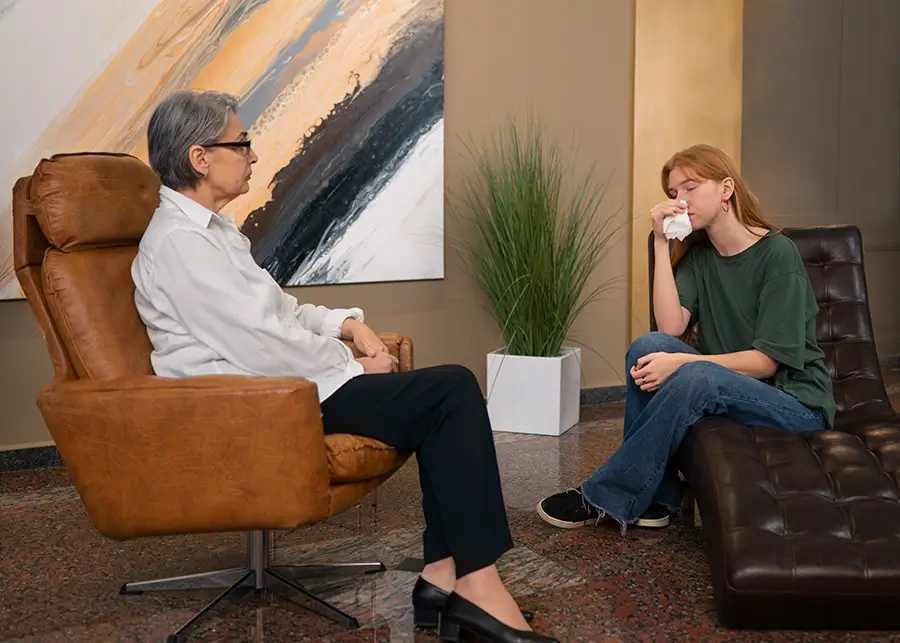If you’re struggling to move beyond trauma, understanding what is Accelerated Resolution Therapy will help you in treating trauma and other mental health issues. Accelerated Resolution Therapy (ART) is a newer, evidence-based method that works well for treating trauma, depression, and other mental health issues. Research shows that ART therapy is very quick, and treatment usually takes around three to four sessions to someone gets healed.
In a HealingUS Podcast Episode, a mother and daughter discuss their family’s struggles with addiction and mental health, particularly focusing on the impact of one daughter’s addiction. They highlight the importance of managing trauma and stress while offering support and setting boundaries. Throughout the conversation, they explore the role of therapies in their healing journey. They explain how ART helped them process traumatic experiences, offering them tools to cope with overwhelming emotions while still being able to offer support and set healthy boundaries. The episode sheds light on the delicate balance between helping a loved one and protecting one’s mental well-being.
This blog provides detailed information on What is Accelerated Resolution Therapy, including its history, uses, how it works, and what to expect from ART therapy. .
Ready to leave trauma behind?
What is Accelerated Resolution Therapy?
Accelerated Resolution Therapy (ART) is a type of psychotherapy that combines two essential techniques: memory reconsolidation and smooth-pursuit eye movements. Together, these help people deal with trauma, anxiety, depression, and sleep problems. Let’s understand in detail:
Memory Reconsolidation
When you recall an emotional memory, your brain makes the memory flexible, or “malleable,” for about six hours. This period is called the reconsolidation window. During ART, a therapist guides you to replace the troubling images tied to this memory with new, peaceful images. Research shows these positive changes can last for months, even a year.
Smooth-Pursuit Eye Movements
This technique involves following the therapist’s hand with your eyes, similar to how you might follow a tennis ball during a match. This movement helps create a relaxation response in the brain. While there’s no definitive proof of how it works, one theory suggests it mimics rapid eye movements (REMs) during dreaming, helping solve problems and promoting positive feelings.
ART is unique because it quickly replaces negative images in your mind with positive ones, often reducing symptoms like nightmares and intrusive thoughts in just a few sessions.
History of Accelerated Resolution Therapy
Accelerated Resolution Therapy (ART) was developed in 2008 by Laney Rosenzweig, LMFT. The therapy aims to help individuals find relief from past trauma through eye movements, typically within just a few sessions.
Comparison to Other Therapies
ART is similar to Eye Movement Desensitization and Reprocessing (EMDR) therapy but is often considered more directive, more accessible to learn, and usually administered in a shorter time frame. It also incorporates elements from Cognitive Behavioral Therapy (CBT) and psychodynamic approaches.
According to research by the National Library of Medicine, ART is more direct, accessible to learn, and often administered in a shorter time than EMDR.
During an ART session, a mental health professional guides the client through a specific process:
Visualization
The client visualizes a distressing event or a metaphor for that event.
Bilateral Eye Movements
The therapist moves their hand from side to side, and the client follows the hand with their eyes. This movement helps in processing the traumatic memory.
Imagery Replacement
The client imagines what they wish would have happened during the traumatic event, replacing negative imagery with positive visualizations.
Studies indicate that individuals receiving ART for post-traumatic stress disorder (PTSD) typically find relief from their symptoms after 1 to 5 hour-long sessions. On average, noticeable results are achieved in about 3.7 sessions.
Uses of Accelerated Resolution Therapy
Accelerated Resolution Therapy (ART) has shown effectiveness in alleviating symptoms associated with post-traumatic stress disorder (PTSD), pain, depression, anxiety, and self-esteem issues.
The ART highlights promising outcomes when therapists apply ART to a range of disorders and challenges, including:
- Anxiety
- Depression
- Phobias
- Panic attacks
- Obsessive-compulsive disorder (OCD)
- PTSD
- Addiction/substance abuse
- Performance anxiety
- Family issues
- Victimization/poor self-image
- Relationship issues/infidelity
- Codependency
- Grief
- Job-related stress
- Pain management
- Memory enhancement
- Dyslexia
What else can ART help treat?
A study conducted in 2013 says that 28 people got healed with ART therapy. The findings suggest that ART is a brief, safe, and effective treatment for adults dealing with both PTSD and depression. However, it’s important to note that the study had limitations, including a small sample size and the absence of a control group.
Another small 2016 study with 10 people suggested that ART might help with:
- Chronic neuropathic pain
- Pain relief
- Sleep improvement
- Mobility
Both studies had limitations and involved the ART creator.
Who can benefit from Accelerated Resolution Therapy?
During the first visit, an ART-trained therapist will decide if ART is right for you by checking three things:
- Can you focus on your problem for more than an hour?
- Can you move your eyes smoothly from side to side during the session?
- Are you really ready to let go of the issues that brought you to therapy?
What’s the goal of Accelerated Resolution Therapy?
The goal of ART therapy is for clients to see a decrease or elimination of their symptoms in an average of one to four sessions. A study on ART for PTSD found that 70% of participants saw a significant drop in their PTSD symptoms. Clients often report similar improvements for other issues.
ART therapists work with clients to set goals for each session. Typically, the goal is to improve the client’s subjective units of distress (SUDs), which measure how much distress they feel from their problem.
How does Accelerated Resolution Therapy work?
Accelerated Resolution Therapy (ART) is a structured process that involves focusing on a troubling memory while following the therapist’s hand with your eyes. This process reduces distress and replaces negative images with positive ones, making the memory less upsetting.

Let’s understand what is Accelerated Resolution Therapy for PTSD, Anxiety, and Eating habits and how it works differently.
1. Accelerated Resolution Therapy for PTSD
If the trauma is from a single event, that event is used as the scene. For multiple traumas, themes are identified, and each theme is addressed in separate sessions. The therapist helps the client to manage distress and change negative images to positive ones.
2. Accelerated Resolution Therapy for Test Anxiety
The client recalls a memory related to test anxiety and follows the same process. They may imagine taking the test in a relaxing setting, like on a beach.
3. Accelerated Resolution Therapy for Eating Issues
ART can complement ongoing treatment with a specialist. The client selects a memory related to their eating issues and works on replacing distressing images with positive ones, like envisioning a prosperous, healthy day.
Your Path to Recovery Begins Here
FAQs
Que: What is accelerated resolution therapy?
Ans: Resolution therapy is a newer, evidence-based approach designed to address trauma, depression, and other mental health issues. It uses eye movements to reduce symptoms often related to past trauma quickly.
Que: How does RRT therapy work?
Ans: Rapid Resolution Therapy (RRT) helps people deal with the lasting effects of trauma through guided imagery, hypnosis, and storytelling to resolve negative thoughts and behaviors.
Que: What age is accelerated resolution therapy for?
Ans: Accelerated Resolution Therapy (ART) can benefit individuals of all ages, including children, teens, and adults, and is effective for conditions like depression and PTSD.
Que: What are the three main types of resolution?
Ans: There are three main types of resolutions: ordinary, extraordinary, and unanimous. Ordinary resolutions are common, special resolutions are less frequent, and unanimous resolutions are rarely needed.
Que: Why is RRT used?
Ans: RRTs generate paths for nonlinear systems with constraints, helping to efficiently find feasible trajectories through complex environments.
Conclusion
Trauma therapy encompasses various psychological methods designed to help manage the effects of trauma. Living with trauma can be challenging and isolating, but you don’t have to face it alone; hope you have learned What is Accelerated Resolution Therapy?.
Effective treatments, such as Accelerated Resolution Therapy (ART) and Rapid Resolution Therapy (RRT), can facilitate recovery. Consulting a qualified therapist skilled in these methods can guide you through these therapies and support your healing journey.









